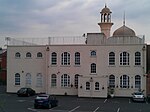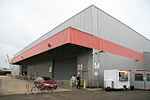Bordesley, Birmingham

Bordesley is an area of Birmingham, England, 1.2 miles (2 km) south east of the city centre straddling the Watery Lane Middleway ring road. It should not be confused with nearby Bordesley Green. Commercial premises dominate to the west of the ring road, but much of this area is to be redeveloped. Blocks of residential apartments are planned and set for completion from the mid-2020s onwards. The largely residential area east of the ring road was renamed Bordesley Village following large scale clearance of back-to-back houses and redevelopment in the 1980s and 90s. Bordesley is the real life setting of the BBC series Peaky Blinders, and home to Birmingham City Football Club's ground, St Andrew's.
Excerpt from the Wikipedia article Bordesley, Birmingham (License: CC BY-SA 3.0, Authors, Images).Bordesley, Birmingham
Artillery Street, Birmingham Digbeth
Geographical coordinates (GPS) Address Nearby Places Show on map
Geographical coordinates (GPS)
| Latitude | Longitude |
|---|---|
| N 52.4799 ° | E -1.8698 ° |
Address
Artillery Street
Artillery Street
B9 4PW Birmingham, Digbeth
England, United Kingdom
Open on Google Maps







